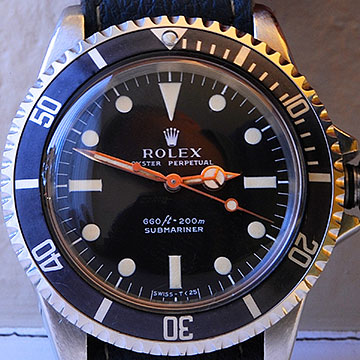See Also: GILT-GLOSS 5512 SUBMARINER 
A COMPREHENSIVE REVIEW OF THE 5513 MATTE DIAL:
FROM METERS FIRST TO MAXI V BY BEAUMONT MILLER II
See Also: GILT-GLOSS 5512 SUBMARINER 
A COMPREHENSIVE REVIEW OF THE 5513 MATTE DIAL:
FROM METERS FIRST TO MAXI V BY BEAUMONT MILLER II
Non SERIF DIAL

photo courtesy of Andrew Shear
SERIF DIAL

photo courtesy of alexmo
Non SERIF & SERIF DIALS
The Non Serif and Serif Dials immediately followed the Meters First Dials. The Non Serif Dials were introduced first around late 1969 to early 1970 consistent with cases stamped with serial numbers in the very early 2.0 million range. The production run of the Serif Dials ran subsequent to the Non Serif Dials and are commonly seen in cases stamped with serial numbers beginning in the early/mid 2.0 million range up until about 1973 consistent with cases stamped in the late 3.0 million range to early 4.0 million range. Cases stamped in the late 3.0 million range begin the transition from Serif Dial back to Non Serif Dial. Finally, the production run of the Non Serif Dial continued until the manufacture of the Pre Comex Dial typically seen in cases stamped in the early to mid 5.0 million range.

It is important to realize that because Rolex transitioned from one dial to the next over such a short period of time that it is not uncommon to see Non Serif and Serif Dials in watches with serial numbers in close proximity to each other. As such, the above information is more of a guide as to which serial number range you would expect to see each dial.
In an effort to understand why each of these dials was named as such, perhaps it would be a good idea to identify the subtle nuances of each dial. Serif is defined as small extensions at the letter’s vertical and horizontal termination points that enhance its appearance and readability. The Non Serif Dial was named for its lack of serif on the paint underneath the tritium of the corners of the 3 o’clock, 6 o’clock, and 9 o’clock hour markers. The corners of each of these rectangular hour plots are perfect 90 degree angles. By contrast, the Serif Dial has a bit of serif on each corners of the 3 o’clock, 6 o’clock, and 9 o’clock hour markers. The serif I am referring to is the little bit of “flair” or sharp points on the corners of these markers.
A note of caution. It is important to remember that the tritium was applied to these dials by hand, and because of this, it is not uncommon to have some tritium covering up the serif on some of these hour markers. A question comes to mind, “How can you tell the difference between a Serif Dial with tritium covering the serif of the hour markers versus a Non Serif Dial?” The answer to this question lies in the print of the “E” in “ROLEX” under the coronet. On the Non Serif Dial the middle horizontal stroke of the letter “E” in “ROLEX” has an abundance of serif at the end. By contrast, on the Serif Dial the middle horizontal stroke of the letter “E” in “ROLEX” has no serif at the end. Is this driving you MAD?
There are other ways to tell the difference between the two dials like the shape of the coronet and the alignment of the letter “P” in “PERPETUAL” underneath the letter “L” in “ROLEX” above it. The NON SERIF DIAL having the “P” in “PERPETUAL” shifted to the left. However, like identifying the “long E” in “ROLEX” on the 1675 Mk I matte GMT dial, identifying the serif or lack of serif on the “E” of this 5513 matte dial may prove helpful.
These dials do share several characteristics in common:
Helpful Hints to recognize the Non Serif and Serif Dials: if it’s a feet first dial with “SUBMARINER” written below the depth rating and the “=” sign is above and slightly to the right of the letter “A” in SUBMARINER, then it is a Non Serif or Serif Dial. To delineate between the two, look at the 3,6, and 9 o’clock hour markers for serif at the corners and the middle horizontal stroke of the “E” in “ROLEX” for the presence of any serif as well.
Click thumbnails below to view full-size images:
Non SERIF DIAL
photo courtesy of Andrew Shear |
DETAIL 1
|
DETAIL 2
|
DETAIL 3
|
SERIF DIAL
photo courtesy of alexmo |
DETAIL 1
|
DETAIL 2
|
DETAIL 3
|